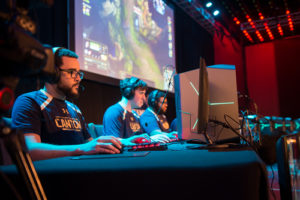Nearly a year ago, SUNY Canton President Zvi Szafran was looking at ways to grow his athletic department. Statistics on student-athletes showed higher GPAs, higher retention rates, and higher graduation rates than the rest of the student body. Recruiting more of these academically successful students was a top priority, and President Szafran had come across an idea that was non-traditional but showed great promise.
Within a few short months, SUNY Canton added three eSports teams and was competing at the varsity level with a number of other forward-thinking colleges and universities around the country. eSports is growing exponentially (the numbers are staggering), and university athletic departments and administrators are taking notice.
In the first article of this three-part series about collegiate eSports, I’ll discuss how SUNY Canton built our eSports program. Stay tuned for parts two and three, which will show how teachers are developing curriculum to support the gaming workforce and what IT departments need to do to make eSports come to life.
The new digital athlete
Ten, five or even two years ago, the association between video games and athletics didn’t exist. Today, however, we’re recruiting and training eSports students that are changing the complexion of traditional college athletic teams.
Generation Z is often referred to as the first digital generation. They grew up using the internet, and according to Nielsen, 73 percent of them have video game consoles. They spend hours each week playing popular games like Fortnite and League of Legends, and, with the launch of Twitch in 2011, live-streaming parties became another new normal that helped pave the way for eSports.
But eSports isn’t just about playing games. Its popularity has opened the door to new career paths in game design and development, and the dream of working in the eSports industry or becoming a professional gamer is now a reality. In fact, Indeed job postings related to eSports are up 18 percent since last year and 57 percent since 2015.
eSports competitors are discussing strategy, holding practices to hone their skills, and competing against one another for championships. It may not be a traditional physical sport, but it shares many of the conventional aspects of a sport: competition, skill, leadership opportunities, teamwork, and entertainment. SUNY Canton was one of the first schools to integrate eSports into its programs and join the National Association of Collegiate Esports (NACE) and the Eastern Collegiate Athletic Conference. As athletic director, it’s my job to help organize teams and competitions, promote the program, and manage the budget.
Encouraging inclusivity
eSports is a great opportunity for students who play video games to represent their college. Because students participate virtually, competitors of all physical abilities can participate in athletics and be a part of a team. Also, students who don’t live on campus can join online, allowing them to be part of a team and increasing their sense of belonging. And more engaged students means increased retention rates.
SUNY Canton’s eSports teams are a mix of women and men, with the exception of an all-women’s Overwatch team. Encouraging mixed-gender teams for eSports puts the recruitment focus on talent rather than gender, improving inclusion overall and helping to fight stereotypes that gaming is male dominated.
Designing the eSports arena
Getting students excited to participate was easy. They were already on campus and extraordinarily eager to compete. In order to grow that enthusiasm for both current and prospective students, we felt the need for a well-equipped playing field. In eSports, that means a digital gaming arena outfitted with monitors, high-performance computers, headsets, speakers, and equipment lockers. It also means investing in a high-speed Wi-Fi network to power the games and equipment. Even a five-millisecond connectivity delay can significantly impact the outcome of the game, making a strong, reliable network connection critical.
After seeing what it could do as the official Wi-Fi technology and analytics provider for the NFL, SUNY Canton partnered with Extreme Networks to design a specialized gaming arena that will open in the Fall 2018 semester. The arena will offer a high-tech, comfortable space for gamers and provide an overall immersive gaming experience for our three competitive teams: Hearthstone, League of Legends, and Overwatch.
The new gaming arena will have 24 lab stations with professional gaming PCs, gaming stations with consoles, and specialized mice and keyboards that react to player movement within milliseconds. We also partnered with Alienware to provide top-rated gaming computers with video cards and high-end peripherals. Additionally, the arena will include five 4K TVs that can hook up to larger screens to project instant replays, and a team meeting space for game review that doubles as a streaming station where the announcer can broadcast the games live on Twitch. All of this will be powered by Extreme’s industry-leading wired and wireless solutions, which provide high speed, high-density Wi-Fi during critical playing times.
Recruiting and retaining a new sport
Since launching the eSports program in December 2017, we’ve seen tremendous uptake. We’ve been able to reach new groups of enrolled students who weren’t previously engaged in campus life and recruit prospective eSports students looking for an opportunity to compete. Today we have more than 30 students enrolled in our program who have participated regularly in competitions throughout the year.
The digital age continues to grow and influence college athletics and provide new ways for students to come together as a team to compete. As eSports becomes more popular, the colleges equipped to embrace the emerging sport will see an increase in student recruitment, engagement, and retention.
Next up in this series is SUNY Canton’s Associate Provost and Dean of Academic Support Services Molly Mott, who will delve into eSports academia and how SUNY Canton is educating students for the future in the industry of game design and eSports.

